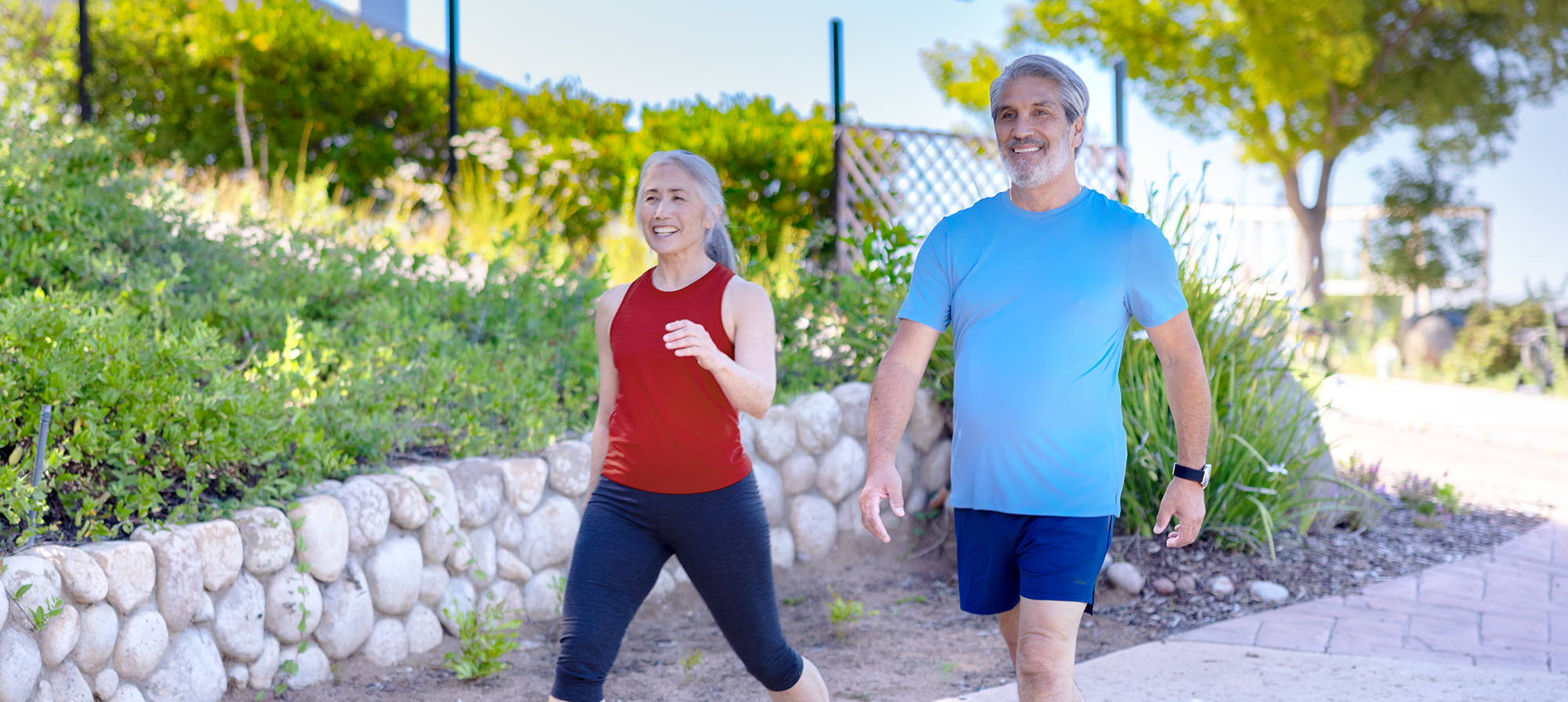What does muscle mass have to do with blood sugar? Quite a bit, it turns out. Recent research has shown that muscle tissue plays a key role in managing your blood sugar. So, whether you have type 2 diabetes (T2D) or are just hoping to prevent it, the more muscle you have, the better. And the path to more muscle is good old-fashioned resistance training.
When you hear about exercise as a way to manage blood sugar, you might think of cardio workouts. It’s true that cardio activities like walking, swimming, cycling, and jogging can help. But this type of activity, which mostly works your heart and lungs, is just part of the picture.
More surprising is the role that strength training seems to play in helping your body use and regulate blood sugar. Strength training involves having your muscles work against some form of resistance. A resistance workout might involve lifting dumbbells, for example. Or it can mean simply lifting your own bodyweight with exercises like push-ups or squats. Such exercises can make you stronger by helping you build more muscle mass.

What does it mean to have high blood sugar—and why does it matter?
To understand how muscle tissue works with blood sugar, it’s helpful to know some blood sugar basics.
First, blood sugar is just a normal source of energy that your body gets from food. More specifically, food that you’ve eaten is broken down to a form of sugar called glucose and then sent into your bloodstream. Think of glucose as the fuel that your body’s cells run on.
Second, before that glucose can be used, it needs some help getting into your cells. This is the role of a hormone called insulin. When insulin is doing its job properly, then glucose feeds your cells, allowing them to do their jobs and keep your body working as it should.
But with age and certain conditions, like T2D (formerly known as adult-onset diabetes), your body can become less able to use its glucose. Then, a couple of not-so-good things can happen.
One is that your cells don’t get the fuel they need to keep your body healthy and functioning.
Another is that the unused glucose (sugar) builds up in your blood. In other words, you develop high blood sugar. And that can become a big deal where your health is concerned.

If too much sugar stays in your blood for long periods of time, the risk for quite a few serious health issues goes up. Among them:
- Damage to nerves, blood vessels, and organs
- Heart disease
- Stroke
- Vision problems
- Non-healing wounds
If you have diabetes, make sure you’ve got as many tools as you can for managing it well. And if you don’t have T2D , take action now to help prevent it.
One great place to start is with muscle.

What does muscle have to do with blood sugar?
One big reason muscle tissue is so important has to do with insulin, or rather, insulin sensitivity. For the insulin-glucose process to work as it should, your body has to sense its insulin and then respond to it. So, one key to managing your blood sugar, especially as you age, is keeping or boosting your insulin sensitivity.
Muscle tissue—especially the muscle tissue that connects to your bones—is very sensitive to insulin. This skeletal muscle helps move sugar from the bloodstream into the cells where it’s needed for energy.
Unfortunately, muscle mass naturally tends to decrease with age. And, as muscle mass decreases, insulin sensitivity will also tend to decrease. But the news here is not all bad. Research shows that the process can be reversed. In other words, you may be able to boost your insulin sensitivity by increasing your muscle mass.
If you’ve never done any strength training—or haven’t done it in a long time—you might have doubts about your ability to build muscle now. But, be assured, building muscle is possible at any age. And the most reliable way to do it is with some form of resistance training (RT).
Before starting a strength training program, be sure to talk with a physical therapist or certified fitness trainer about what type of routine might be best for your needs.
How does resistance training build muscle?
RT, which includes traditional weight training, is a tried-and-true way to build muscle. RT works by taxing muscles with a greater workload than they’re used to. Your muscles work to meet that increased demand, and then they adapt by getting a little bigger and stronger.
There are many ways to incorporate resistance training into your fitness routine. For example, you might use:
- Free weights, such as dumbbells or kettlebells
- Weight machines
- Resistance bands or tubing
- Your own body weight: e.g., squats, lunges , pushups, pull-ups, planks
All of these are effective in making muscles stronger if the workload or weight is enough to stimulate muscle growth.

How do I start resistance training?
The best workout routine for you is the one that is designed for you. So, work with your physical therapist or a certified personal trainer to create a strength training plan that meets you where you are. As you get stronger, you can build on that routine.
A physical therapist or trainer can also check your form and make sure you are training safely. This is very important when you’re just getting started. Once you learn what to do, you may be able to work out on your own safely.
A good RT routine includes rest days. Allowing 2 to 3 days to rest and recover after resistance workouts is an important part of growing stronger muscles.

Resistance training as part of a lifestyle
The rewards of RT go beyond muscle gains and improved blood sugar management. Strength training, in any form, can also make your bones stronger, reducing the risk for fractures. It can boost your metabolism, which can give you more energy and help you manage your weight. And it can help tame arthritis pain.
Whether your blood sugar readings are normal, heading above normal, or in the diabetes range, be sure to make time for RT. Combined with other healthy habits, it can go a long way toward keeping your blood sugar managed and your health optimized.
Not a Silver&Fit® member? Learn more about everything the program has to offer, including more helpful healthy living tips like this, here on our website.
This information is not intended to take the place of regular medical care or advice. Please check with your doctor before using this information or beginning any self-care program. Images used for this article do not depict any members of the Silver&Fit Program.
References
Center for Disease Control and Prevention. (2024, April 24). Benefits of Physical Activity. Physical Activity Basics. https://www.cdc.gov/physical-activity-basics/benefits/index.html
Cleveland Clinic. (2023, March 2). Hyperglycemia (high blood sugar). https://my.clevelandclinic.org/health/diseases/9815-hyperglycemia-high-blood-sugar
Colberg, S. R., Sigal, R. J., Yardley, J. E., Riddell, M. C., Dunstan, D. W., Dempsey, P. C., Horton, E. S., Castorino, K., & Tate, D. F. (2016). Physical Activity/Exercise and Diabetes: A Position Statement of the American Diabetes Association. Diabetes Care, 39(11), 2065–2079. https://doi.org/10.2337/dc16-1728
Dai, X., Zhai, L., Chen, Q., Miller, J. D., Lu, L., Hsue, C., Liu, L., Yuan, X., Wei, W., Ma, X., Fang, Z., Zhao, W., Liu, Y., Huang, F., Lou, Q. (2019). Two-year-supervised resistance training prevented diabetes incidence in people with prediabetes: A randomised control trial. Diabetes/Metabolism Research and Reviews. Jul;35(5), e3143. doi:10.1002/dmrr.3143
Lee, J., Kim, D., & Kim, C. (2017). Resistance training for glycemic control, muscular strength, and lean body mass in old type 2 diabetic patients: A meta-analysis. Diabetes Therapy: Research, Treatment and Education of Diabetes and Related Disorders, 8(3), 459–473. https://doi.org/10.1007/s13300-017-0258-3
Mayo Clinic. (2024, March 29). Fitness basics. https://www.mayoclinic.org/healthy-lifestyle/fitness/expert-answers/hlv-20049447?redate=27122016&p=1
Mayo Clinic. (2023, March 14). Type 2 diabetes. https://www.mayoclinic.org/diseases-conditions/type-2-diabetes/symptoms-causes/syc-20351193
Mayo Clinic Staff. (2023, April 29). Strength training: Get stronger, leaner, healthier. Mayo Clinic.
https://www.mayoclinic.org/healthy-lifestyle/fitness/in-depth/strength-training/art-20046670
Mazibuko-Mbeje, S. E., Dludla, P. V., Nkambule, B. B., Obonye, N., and Louw, J. (2018). The role of glucose and fatty acid metabolism in the development of insulin resistance in skeletal muscle. IntechOpen. doi:10.5772/intechopen.75904.
Qadir, R., Sculthorpe, N. F., Todd, T., Brown, E. C. (2021). Effectiveness of resistance training and associated program characteristics in patients at risk for type 2 diabetes: A systematic review and meta-analysis. Sports Medicine — Open. May 29;7(1), 38. doi:10.1186/s40798-021-00321-x
Shou, J., Chen, P. J., & Xiao, W. H. (2020, February 11). Mechanism of increased risk of insulin resistance in aging skeletal muscle. Diabetology & Metabolic Syndrome, 12, 14. https://doi.org/10.1186/s13098-020-0523-x
Wang, Y., Lee, D. C., Brellenthin, A. G., Sui, X., Church, T. S., Lavie, C. J., Blair, S. N. (2019) Association of muscular strength and incidence of type 2 diabetes. Mayo Clinic Proceedings. Apr;94(4), 643-651. doi:10.1016/j.mayocp.2018.08.037
This article was written by Sharon Odegaard, edited by Candace Hodges, and clinically reviewed by Jaynie Bjornaraa, PhD, MPH, PT, SCS, LAT, ATC, CSCS, CSPS, on January 24, 2025.





